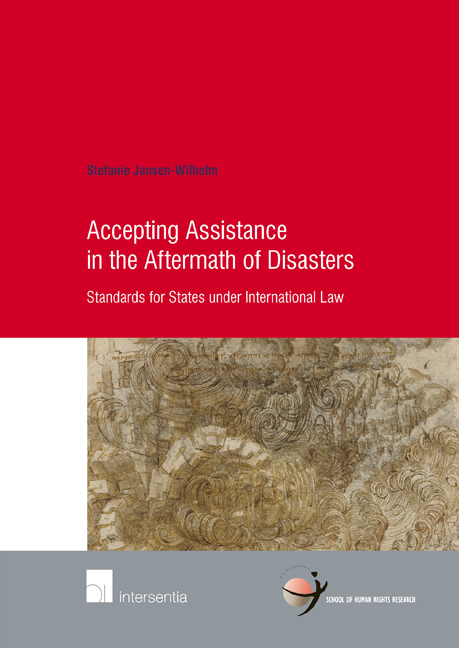Book contents
- Frontmatter
- Dedication
- Acknowledgements
- Contents
- List of Abbreviations
- Part I
- Chapter I General Introduction
- Chapter II Disaster Response and International Humanitarian Assistance: Background and Legal Framework
- Chapter III Practical Application of the Rules on International Humanitarian Assistance in Response to Disasters
- Preliminary Conclusions
- Part II
- Summary
- Bibliography
- Index
- Curriculum Vitae
- School of Human Rights Research Series
Chapter I - General Introduction
from Part I
Published online by Cambridge University Press: 12 December 2017
- Frontmatter
- Dedication
- Acknowledgements
- Contents
- List of Abbreviations
- Part I
- Chapter I General Introduction
- Chapter II Disaster Response and International Humanitarian Assistance: Background and Legal Framework
- Chapter III Practical Application of the Rules on International Humanitarian Assistance in Response to Disasters
- Preliminary Conclusions
- Part II
- Summary
- Bibliography
- Index
- Curriculum Vitae
- School of Human Rights Research Series
Summary
INTRODUCTION
Disaster strikes
Disasters will always have certain consequences in terms of casualties, injuries, and material damage, although the degree varies from one disaster to another. It is up to the state on which territory the disaster takes place (that state will henceforth be referred to as the ‘affected state’) to address these consequences. In some cases, the damage as a result of the disaster is so severe that a state needs assistance from others – like states, international organisations, NGOs or a combination of these – to respond to a disaster and to work on reconstruction. The earthquake that struck Haiti in 2010 provides a clear example of a disaster where international assistance was needed and requested by the state.
In the late afternoon of 12 January 2010, an earthquake with a magnitude of 7.0 Mw struck Haiti, its epicentre lying about 25 kilometres from Port-au-Prince. Not only due to the enormous scale of the disaster but also because it is one of the poorest countries in the Americas, Haiti found itself struggling to cope with the consequences of the earthquake. The damage was indeed of massive proportions. Over 200.000 people were killed and many homes were destroyed along with the capital's main infrastructure. Survivors tried to find refuge with relatives in the countryside or – in most cases – found shelter in refugee camps. For the distribution of tents, water and food the refugees were largely depending on international humanitarian aid, delivered with the permission of Haiti's government.
Not in all disasters is the affected state willing to make use of aid offered by international actors. When the Italian city of L'Aquila was hit by an earthquake in 2009, the Italian government made clear that international assistance for reconstruction was not required. The L'Aquila earthquake, which struck on 6 April at 3:32 am local time with a magnitude of 6.3 Mw, killed over 300 people and made around 55,000 people homeless. Many buildings in the historic centre of the city were damaged. The total cost of the earthquake was estimated at 2.5 billion US dollars and yet – at the time – Prime Minister Silvio Berlusconi stated that ‘Italians were “proud people” and had sufficient resources to deal with the crisis’. Italy did therefore not make use of offers of aid made by international actors.
- Type
- Chapter
- Information
- Accepting Assistance in the Aftermath of DisastersStandards for States under International Law, pp. 3 - 22Publisher: IntersentiaPrint publication year: 2015

